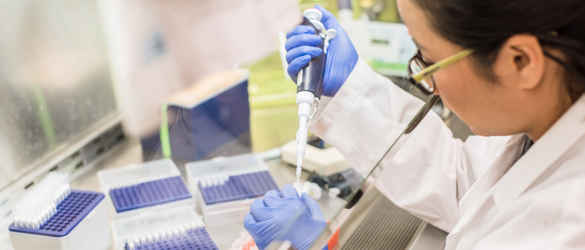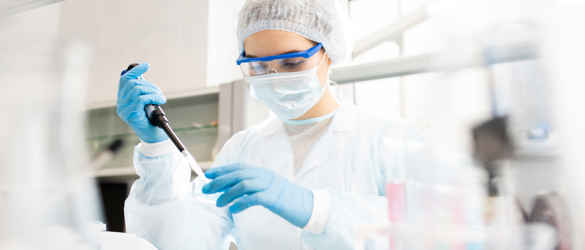
Gene therapy
Gene therapy is a new form of treatment that involves adding, removing or editing genes in your cells. Almost every cell of your body contains your DNA, and your DNA is made up of hundreds of thousands of genes which make you unique.
However, genes can become changed, and these mutated genes can cause cells to behave abnormally or die. The mutated genes can also be passed on to children.
Genetic causes of macular disease
Many macular dystrophies, such as Stargardt disease, Best disease and Sorsby Fundus dystrophy, are due to a mutation in a single gene. These diseases are often seen to run in families; children may inherit the harmful changes in a gene from either their mother or father or from both of their parents.
The faulty gene can lead to the cells in the macula not functioning correctly, or can cause cell death, therefore leading to vision loss.
However, through gene therapy, researchers are hoping to be able to stop the effects of the mutation by fixing, removing or replacing the faulty gene with a healthy copy of the gene.
The Macular Society has funded multiple research projects looking at creating a variety of gene therapies for different macular dystrophies.
Gene therapies are also being investigated for macular dystrophies, as they are inherited conditions. If we can fix the mutation in the affected gene we could hopefully stop the condition. There are a few different ways researchers are looking into gene therapy.
One way is adding new healthy copy of the affected gene into the eye. The idea is that by adding more of the healthy gene, we are giving more instructions to make the healthy copy of the protein the gene produces and this may restore more function to the eye.
Gene editing is another technique being used. This is more complex as it involves fixing the mutation in the affected gene. This can hopefully remove the faulty mutation and restore the gene to a healthy copy and may stop the disease. However, as there are a number of different mutations in the gene that causes macular dystrophies it can be very particular and may require individualised treatments for each mutation, which can make treatment slow and expensive. We have a project looking into this area of research for Stargardt disease.
Research is also looking at other gene therapies to increase or decrease the expression of genes related to macular dystrophies. Gene expression controls how much or if any protein is produced from the gene. In some macular dystrophies the mutation in the gene causes less protein to be produced or for the protein to be less functional, so increasing gene expression can help improve the function of the macula, we are funding research into this for Stargardt and Best disease. In other macular dystrophies the mutation in the gene causes a protein to be produced which has a harmful effect on the cells of the eye, therefore stopping the expression of the gene can help keep the macular cells healthy. There is a project investigating this for Doyne Honeycomb Dystrophy.
We are currently funding research into different areas of gene therapy for macular dystrophies. You can find out more about these projects.
Using gene editing to stop progression of Stargardt disease
Professor MacLaren's gene editing project at Oxford aims to halt Stargardt disease by fixing ABCA4 gene mutations, offering hope for vision preservation.
Switching off the genes that cause Best disease
Using new gene editing technique to turn off the faulty gene that causes vision loss in Best disease.
Gene therapy and AMD
We also know that genetics play a part in the risk of developing age-related macular degeneration (AMD). However, lifestyle factors are also involved in the risk of developing AMD and how fast the disease progresses.
As there is not one single faulty gene causing AMD, it is not as simple to fix any genetic mutations, compared to the macular dystrophies. Instead, researchers are looking at creating a ‘drug factory’ in the eye using gene therapy, as a treatment for AMD.
Researchers are investigating adding a gene to the cells of the macula that is the code to make a drug. The therapy works by adding the gene which acts as instructions for the cells of the eye to produce anti-VEGF drug. This allows the cells of the eye to create the wet AMD drug itself. For patients with wet AMD who receive frequent anti-VEGF injections, a single injection of a gene may be preferable to regular eye injections. Results from current trial of wet AMD gene therapy has shown in some people the eye is able to produce the drug for 5 years. There is a phase 3 trial called LUNA being done by the company Adverum Therapeutics currently underway.
Current stage of gene therapy
Unfortunately, gene therapies for macular dystrophies and AMD are not currently available, some therapies are in clinical trials and many more being investigated in earlier research. We do not yet know when they will be available to patients. You can find more information about the clinical trial process and research in Take part in research.
Where research is now
Information about new treatments such as stem cell and gene therapy, and how they can help people with macular disease.
Explore our research
Beating macular disease through funding medical research and improving the lives of those living with macular disease.
Get involved in research
Patients have a very important part to play in medical research. Without them we would not have the treatments we have today and new and improved treatments would not be possible.
Research news
The latest developments in the search for better treatments and a cure for macular disease.
Get the latest research news from the Macular Society
To hear about life-changing research and treatments, subscribe to our monthly enewsletter today. Together we can Beat Macular Disease.
Sign up to our free email newsletter







